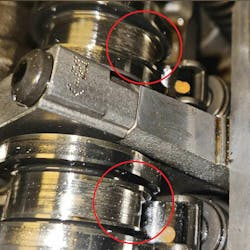A 2019 Dodge Durango with a 3.6L engine was showing DTC P0300 and misfires being flagged for cylinder No. 1. According to the technician, the PCM only registered misfires above 3,000 rpm.
Get caught up with the full story on this vehicle here.
These were the four options on the table:
- Condemn intake valve integrity for cylinder No. 1
- Condemn exhaust valve integrity for cylinder No. 1
- Condemn engine for multiple cylinders’ valve integrity
- Inspect for a bank-to-bank breathability issue
For those of you who chose answer No. 4, congratulations! In combination, the pattern of the cranking intake vacuum trace and the engine configuration alluded to a variation in breathability. We have to keep in mind that even though the PCM was counting misfires consistently for cylinder No. 1, a threshold must be crossed to set a DTC. The nature of the intake pattern suggested an inspection of a bank-to-bank breathability of would-be time better spent.
The next logical test would be the inspection of the timing components. Even though this was not carried out, a multi-trace scope capture comparing CMPs to CKP would yield the conclusive data we needed to infer a timing issue. Simply triggering from an ignition sync would stabilize the pattern and allow us to see a correlation between CMPs and CKP as varying, even if the chain had not yet jumped a tooth (or several teeth).
My friend Rick chose the simple process of removing the valve covers for inspection of the valvetrain. Not only did he discover that timing was still correct, but he also discovered the root cause of the fault. The intake cam lobes were significantly worn, leaving all three cylinders of bank No. 1 deficient of air, under higher rpm conditions (See image).
Answer No. 1 is incorrect. Although cylinder No. 1 was suspected of being the sole malfunctioning cylinder, the data proved the fault was a bank-to-bank issue.
Answer No. 2 is incorrect for the same reason that answer No. 1 was incorrect.
Answer No. 3 is incorrect. Although replacement of the engine is a more prudent step in many situations, (especially this featured engine platform), it is not the correct diagnosis. If that were the case, replacing the engine for every mechanical fault present would be called for. Obviously, this is not cost-effective for the client.
Be sure to read the next Motor Age issue for the answer to this month’s challenge and what was discovered!
About the Author
Brandon Steckler
Technical Editor | Motor Age
Brandon began his career in Northampton County Community College in Bethlehem, Pennsylvania, where he was a student of GM’s Automotive Service Educational program. In 2001, he graduated top of his class and earned the GM Leadership award for his efforts. He later began working as a technician at a Saturn dealership in Reading, Pennsylvania, where he quickly attained Master Technician status. He later transitioned to working with Hondas, where he aggressively worked to attain another Master Technician status.
Always having a passion for a full understanding of system/component functionality, he rapidly earned a reputation for deciphering strange failures at an efficient pace and became known as an information specialist among the staff and peers at the dealership. In search of new challenges, he transitioned away from the dealership and to the independent world, where he specialized in diagnostics and driveability.
Today, he is an instructor with both Carquest Technical Institute and Worldpac Training Institute. Along with beta testing for Automotive Test Solutions, he develops curriculum/submits case studies for educational purposes. Through Steckler Automotive Technical Services, LLC., Brandon also provides telephone and live technical support, as well as private training, for technicians all across the world.
Brandon holds ASE certifications A1-A9 as well as C1 (Service Consultant). He is certified as an Advanced Level Specialist in L1 (Advanced Engine Performance), L2 (Advanced Diesel Engine Performance), L3 (Hybrid/EV Specialist), L4 (ADAS) and xEV-Level 2 (Technician electrical safety).
He contributes weekly to Facebook automotive chat groups, has authored several books and classes, and truly enjoys traveling across the globe to help other technicians attain a level of understanding that will serve them well throughout their careers.

